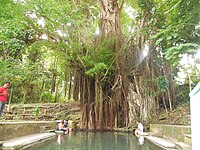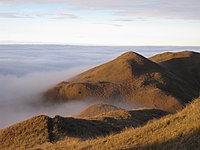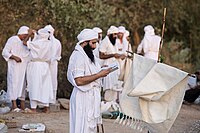Religion in Orioni
Religion in Orioni in 2018 (age 18+).
Religion in Orioni is dominated by several different main religions. Amisti is the ethnic religion of the Orinese people with 62% followers. And Elitism is the second largest with 25%. There are also the Salamic and Christian minority religions. Orioni differs from other countries on Eurth where Christians or Salamids are the overwhelming majority.
Amisti
“Listen to the sound of water. Listen to the water running through chasms and rocks. It is the minor streams that make a loud noise, the great waters flow silently.”
— Sahini (4th Century BCE)
Amisti is the indigenous religion of people on the Orinese islands, a religion as old as the country itself. Amisti is the largest religion in Orioni, practised by circa 62% of the population. In the 4th century BCE, the Classical "the father of linguistics" Sahini invented the word Amisti to distinguished the existing but undefined faith in Orioni from foreign influences spreading throughout the Orient. In the 5th century, the Aroman mercenary soldier and historian Ammianus Marcellinus stated that the Orinese had no religion, but this seems incredibly unlikely. Amisti is a way of life, rather than a specific set of beliefs. Amisti doesn’t have many of the characteristics associated with religion. Unlike Christianity or Salam, it doesn’t worship a central deity, define an official founder or follow a sacred text. Amisti doesn’t explain the world as right and wrong. There are no Amisti preachers or missionaries.
Beliefs
What exactly the early Orinese believed and how exactly they worshipped is unknown. But it is inferred that they were animists. The Amisti religion is generally characterised by the belief that Amilaki (Oharic: spirits, gods) live in everything. While specific legends and traditions may vary slightly from place to place and island to island, the people showed reverence for natural forces and elements of the Eurth, including water, wind, rain, thunder, lightning and others which they believed possessed a spirit. Importantly, Amilaki is both singular and plural, referring not only to the many spirits in the world, but also the 'life essence' or mabui that connects all things. This essence of sacred spirits manifests in many eurthly forms: mountains, rocks, trees, rivers, animals, places, in concepts like fertility, and even people can be said to possess the essence of Amilaki.
The Orinese probably perceived the origins of these many forces in the sea, worshipping water below as the font of all creation and using sacrifice and worship in an attempt to control their destiny. Treatment of the environment plays a large part in shaping a culture’s religion. In Amisti, because everything possesses a spiritual component, the religion is non-anthropocentric. Humans aren’t at the centre of the universe. In essence, this means that Amisti deals with a lot of peace and love between human and nature. People are not separate individuals. They exist within the same world and share its interrelated complexity. This interconnectedness is critical to understanding the Amisti religion. In contrast, People of the Book often state that man has “dominion over fish of the sea, and over fowl of the air, and over every living thing that moveth upon the earth”. In Book religions, nature has historically been a subject to be used. Whereas someone else might see a giant tree and think, “Wow, that’s a big f***ing tree”, a practitioner of Amisti might recognise it as an Amilaki, an object in which a spirit can reside. It’s no longer just nature, but part of the divine fabric of reality and deserves respect.
Rituals

Although Amisti is thousands of years old, it still has an active presence in Orinese life. Prayers and offerings to spirits at Amisti shrines and festivals wash away evil spirits and purify a person or object. This process is the lifeblood of the Amisti practice, happening on a daily, weekly, seasonal and annual basis.
Many Orinese people keep a tiny shrine-altar in their homes. The only thing Orioni has more of than vending machines are shrines. Local shrines play a huge role in communities. They bring people together for festivals and hosting weddings and funerals. Whether they identify as religious, everyone in Orioni is, in some sense, a part of Amisti. While Orioni is one of the least religious countries in the wurld, over 80% of its population participates in some Amisti traditions. These rituals include weddings, funerals, worship at a Shrine or at home, and large festivals. The only goal of Amisti is to be in touch with spiritual essence through sacred rituals. In fact, taking part in ritualistic worship and purification is the entire faith. Purification is a central tenet of Amisti. For instance, newly constructed buildings are also "purified". And many Orinese-made cars are purified during the assembly process. Even Orinese-owned businesses built outside the country are often ceremonially blessed. They receive annual visits by a priest to re-purify. This has garnered criticism, as some liken Amisti worship to a performance rather than an act of devotion based on values and beliefs. However, adherents to Amisti think of rituals as a religious experience that binds a community together.
This belief also includes ancestor worship (more accurately termed "ancestor respect") and the respecting of relationships between the living, the dead, and the gods and spirits of the natural world. Some of its beliefs, such as those concerning genius loci spirits and many other beings classified between gods and humans, are indicative of its ancient animistic roots, as is its concern with mabui, or life essence.
Creation story
Amisti believes in a philosophical creation story. Imama Ahiri (Oharic: Sea Mother) is the ancient spirit goddess of sea and fishes. In some regions of Orioni, people believed she was the goddess of all bodies of water, including lakes, rivers, and even human-made watercourses. Imama Ahiri was more important to people living beside the coastal regions due to nearness and dependence upon the sea. She came to be known as the guardian of sailors and fishermen. When the spirits of water and wind merged into one another, they created the eggs from which all life came. These eggs burst forth into the light and the heavens. One of these eggs was taken into the sky by a bird. The bird flew to a nearby island to build its nest. When it found a tree and landed the bird dropped its egg. The egg broke in two equal halves and revealed the first humans: the divine twins Yemo and her husband Manu, the first man. Amisti beliefs in Imama Ahiri and other water deities indicate that the people back then understood the basics of the hydrological cycle. They knew the seawater was replenishing the rain, which then fell over the ground.
Afterlife
Much like the creation story, old Orinese folk stories also show evidence of a belief in some form of afterlife. In many of these stories, a body of water had to be crossed to allow entrance to an "Otherworld" or Lelalemi in Oharic. This water was thought to wash away sins and memories. This contrasts with other myths that feature wisdom-imparting waters, suggesting that while the memories of the deceased are washed away, a drinker of the waters would gain inspiration. The deceased would commonly encounter either a whale in the capacity of a guardian of the Otherworld or a dolphin as the wanderer's guide. This story is paralleled in later folk stories from other traditions such as Sinbad the Sailor and Pinocchio. And it was usually an old man that transported the deceased across this water.
Lelalemi itself is almost always depicted as an archipelago of many small islands to the east. The ruler of Lelalemi was possibly Yemo, the divine twin sister of Manu the first man. These islands were sometimes mentioned in the oral tradition and even on some maps of Orioni during the medieval era. One example of this influence is the appearance in the second Voyage of Captain Uma "the Navigator", renowned for his legendary voyage to the "Land of the Biruki (Blessed)", which were verdant islands covered with vegetation. The most commonly illustrated adventure is his landing on an island that turned out to be a giant sea monster named "Syona" or "Chiona".
Elitism
The second major religion in Orioni is Elitism, a monotheistic form of worship. For those who belong to the church of Elitism, Ēl or Il is the supreme Goddess, the mother of mankind and all creatures. She is identified as the solar goddess, described as dwelling in the Oriental Ocean, and rising out of the waters in the morning and furnishing mankind with instruction in writing, the arts and the various sciences. Several classical sources describe how: "and that when droughts occurred, they [worshippers] stretched out their hands to heaven towards the sun; for her alone (she says) they regarded as goddess lady of heaven, calling her El, which is in the Meharic language 'mistress of heaven.' For the women since those days had ruled their tribes." According to the established thealogy, El and her husband Elyon had two children: their names are Meda and Aeon, and they were the first mortal humans. Meda was married to Medeapolis (polis = city). This marriage of the divinity with the city would seem to have religious parallels too with the stories of the link between other ancient cities.
Elitism emerged in the 4th Century CE. The socio-cultural landscape at the time was already populated with plenty of complex religious and organised social institutions. Elitism emerged as indirect, intentional opposition to these existing institutions.
The devout believers formed a crusade in order to bring Elitism to all unbelievers of the Eurth or destroy them. The Army consisted of numerous soldiers who firmly believed in the teachings in the Book of Elitism.
WIP:
- Al-Lat: "It has been hypothesised that Allah was the consort of al-Lat, given that it is typical of deities in that area of the world to have consorts."
- This water-deity has a name by which Orinese tribes knew it, and which is also familiar to many modern people - Ēl or Il, a goddess which tribal priestesses would appease with their songs and drums.
- Turn El into a male god again, while making his mother more important
- Rewrite to have a much later start date
- Import via Medanese mercenaries from Memopotamia
- Relate El to Elohim (Hebrew), Elah (Aramaic), Allah (Arabic) and al-ilāh
- See this other fusion-religion: Caodaism
- El, "the kind, the compassionate", "the creator of creatures", was the chief of the Canaanite gods,[34] and he, not Yahweh, was the original "God of Israel"—the word "Israel" is based on the name El rather than Yahweh. He lived in a tent on a mountain from whose base originated all the fresh waters of the world, with the goddess Asherah as his consort. (Source)
Satirism
Satirism is an off-shoot branch of Elitism. The Satirist school of thought emerged in reverence of failed Akrep uprising against the Orinese empress. It set a precedent for revolution against corrupt rulers. Satirism doesn't believe in the infallibility of Elite leaders, instead they believe in divine inspiration. It might be said that Satirese find it difficult to remain passive in an unjust world.
WIP:
- If Elitism is high culture, then Satirism is a counter-reaction based on low culture.
- Make it a funny mix of the Satyr, Diogenes, Dionysos, Bacchus, Hedonism.
- Brought into Orioni during the Civil war when Loyalists hired Buranian mercenaries.
Other
- 4% Salam.
- 2% Christianity and especially Collyridianism.
- 7% other, including Yehuda, !Buddhism and various smaller religions.










